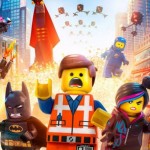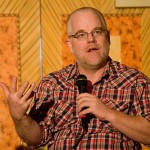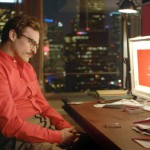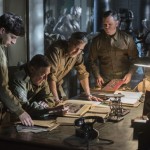Each week in The Moviegoer, Nick Olson examines new and upcoming films.
My family has a wonderful Christmas tradition. We love to go see a movie together during the week before Christmas. Peter Jackson’s Lord of the Rings trilogy became a three year fixture of this tradition. So it was a given that the family planned to make The Hobbit this year’s Christmas outing to the theater. Out of loyalty to this tradition, I’ve avoided seeing The Hobbit until we go together in the next few days. This means I won’t be reviewing the film before Christmas arrives; and, frankly, given the avalanche of takes on the film that has arrived already, I’m not sure that I’ll be delivering one for this space unless I get especially inspired. Either way, I didn’t want to leave you hanging, so I’ve gathered the most interesting bits from the most interesting reviews that I’ve read. Feel free to post your own take in the comment thread.
Oh, and Merry Christmas.
Unexpected Journey does get some things right. Most crucially, there is the moment of grace when Bilbo, wearing the ring, has Gollum at his mercy but makes another choice. Perhaps this is one instance where having made the Rings films first impressed on the filmmakers the importance of this moment, and it pays off beautifully.
Sometimes even something added by the filmmakers works. Gandalf has a nicely Tolkienesque speech that’s not in the book but feels like something Gandalf might have said:
“Saruman believes that it is only great power that can hold evil in check. That is not what I’ve found. I found it is the small things, everyday deeds of ordinary folk, that keep the darkness at bay. Simple acts of kindness and love.”
Alas, the movie has no time to actually celebrate such “small things,” “everyday deeds” or “simple acts.”
But where Tolkien served the head and the heart, Jackson serves the appetite for adrenalin rush. In this sense, he’s Bilbo’s opposite. He’s only comfortable doing what is outrageous and chaotic. For him, it would be a real adventure to delve into quieter moments, soul-searching, and a thoughtful sense of pacing and progress. But every time he takes one step forward, he stumbles two steps back into the familiar.
“All good stories deserve embellishment,” Gandalf tells Bilbo. That’s not true if embellishment contradicts (and even crushes) what made a story good in the first place. Presented in 3D—at the much-hyped forty-eight frames per second—An Unexpected Journey has more in common with amusement parks than literature.
The Hobbit is a dreary affair, made more so by the realization, about ten minutes into the film, that there will be nine more hours over the next three years. Over at The Thin Place podcast, Todd Truffin and I have done the dull but necessary drudge work of itemizing the worst of Jackson’s offenses against J. R. R. Tolkien’s book for those whose cinematic judgments are dependent upon a devotee’s insistence that when it comes to literary adaptations, “getting it right” is a phrase that can have actual meaning, so I won’t repeat the litany here.
Neither will I spend too much time lamenting the seemingly curious decision to use a franchise centerpiece to experiment (unsuccessfully, in my opinion) with projecting at forty-eight frames per second. Audiences may be resigned to pointless 3D in every other movie, but this is an artistic choice that dwarfs every other choice in the film, makes it nearly impossible to think about anything else on a first viewing. Maybe this is what the first audience that saw deep focus struggled with. The art design in the establishing shots looks sublime, but the second anyone moves it is like a painting moving around.
My review of The Hobbit in one word: Meh.
My review of The Hobbit in twelve words: Freeman’s magnificent, but the human story is overwhelmed by video-game aesthetics.
I was pretty close to the fourth of the four Hobbit-anticipating camps I presented the other day, but it turned out that I only got to spend about an hour-and-a-half in Middle-earth, and had to spend the rest in a Tolkien-trademarked version of World of Warcraft.
Yes, the An Unexpected Journey’s scenes are cool to watch (to a point), but the ever-increasing stunts — be it perilously swinging bridge or a wooden platform with many of our heroes falling hundreds of feet — become ever-increasingly over-the-top, presumably to get the adrenaline flowing. They ultimately become so ludicrous that you never once doubt that our heroes are going to survive. Try as some of its scenes might, there’s nothing in An Unexpected Journey that compares to the scene in The Fellowship of the Ring where our heroes are precariously perched on a swaying, crumbling bridge. Indeed, I think it’s safe to say that I never once felt any sort of danger or threat during the film except when Bilbo is swapping riddles with Gollum.
But that has often been the case with Jackson’s Tolkien films: the smaller, quieter scenes are the best, the deepest, the most stirring, the most action-packed. But Jackson is a maximalist: for him, more is never enough — even if that means adding in decidedly un-Tolkien-ish material, such as crude humor or gruesome spectacle. And so we get three Hobbit movies, instead of the original plan for two, which gives even greater opportunity, if not license, for spectacle. And as much as I enjoyed returning to Middle-earth, I worry that Middle-earth might end up becoming something other than what I’ve come to know and love via Lord of the Rings.
In the novel version of The Hobbit, these conflicting impulses towards peace and war are worked through and emphasized by the book’s narrative pacing. Sequences of violent tension alternate with oases of calm, so that the allure of tranquil rest—Bilbo’s hobbit hole, or the joyful glades of Rivendell—are contrasted with the adrenalin rush of terror and smiting one’s enemies. The film too makes occasional rhetorical tributes to home and peace, but it is constructed according to the familiar Hollywood logic of ADD and remorseless action. You can rest when you get out of the theater. While your butt is in the chair and the 3-D glasses are on your noggin, you’re going to be treated to triumphant swelling strings and bloody spectacle after bloody spectacle. Tokien’s novel saw virtue in little things, but An Unexpected Journey is too obsessed with its own bigness for mercy.
The previous trilogy was careful to flesh out the nine characters who made up the Fellowship of the Ring, and to clearly explain the bonds of friendship that connected them; what’s more, two of them were dead before the first movie ended, and we felt their loss deeply. In the new film, however, the dwarves are a mostly undifferentiated group and, even though there are fifteen people in their company (counting Bilbo and Gandalf), we never get the sense that any of them are really in all that much danger, even as they come across one set of monsters after another.
In addition, not only is Bilbo a stranger to both Gandalf and the dwarves, but we never get a sense of him as part of a community with his fellow Hobbits. The birthday-party sequence in the previous trilogy allowed Jackson to establish which Hobbits were relatives, which ones were friends, which ones were afraid to dance with girls, and so on. But here, the concept of a “home” that Bilbo pines for on his journey is little more than an abstraction.
The comparative playfulness of the novel could have made this “Hobbit” movie a lot of fun, but over the years Mr. Jackson seems to have shed most of the exuberant, gleefully obnoxious whimsy that can be found in early films like “Meet the Feebles” and “Dead Alive.” A trace of his impish old spirit survives in some of the creature designs in “The Hobbit” — notably a gelatinous and gigantic Great Goblin and an encampment of cretinous, Three-Stooges-like trolls — but Tolkien’s inventive, episodic tale of a modest homebody on a dangerous journey has been turned into an overscale and plodding spectacle.
Indeed, in his physicality Gollum reminds me of Cornelius Plantinga Jr.’s Not the Way It’s Supposed to Be: A Breviary of Sin, in which he describes sin as “a parasite, an uninvited guest that keeps tapping its host for sustenance.” Having given his life over to the ring, Gollum has suffered moral devolution of sorts, in which someone full of good-natured life has become decrepit and vicious. It’s like watching a noble land animal slink back into the sea.
As in the Lord of the Rings films, Jackson and his filmmaking team bring Gollum to life with a dazzling mixture of artistry and technology. Actor Andy Serkis provides the voice and movements for the character, which is then fleshed out via computer-generated animation. Much of An Unexpected Journey is technically shaky – Jackson employs a new digital camera that lends a flatness to many of the scenes – but this central sequence between Gollum and Bilbo is astonishing. As he bargains with Bilbo over the lost hobbit’s fate (they play a game of riddles to determine whether Gollum will eat him or not), Gollum hovers in the darkness like an unholy ghost, a despicable, disgusting specter.
“An Unexpected Journey” was shot in 3-D and filmed at forty-eight frames per second, as opposed to the standard twenty-four. This sounds miraculous, and you will indeed notice and marvel at the difference, but only if you happen to be a snowy owl who likes watching voles from a hundred and fifty yards. The rest of us will be reminded of high-definition television—better known, in my household, as a reason to avoid viewing films on TV, unless they contain characters named Woody and Buzz. HD has the unfortunate effect of turning every film into what appears to be a documentary about a film set, not just warts-and-all but carefully supplying extra warts where a wart has no right to be. There is something awry in the idea that Tolkien’s wondrous inventions—an entire history and landscape, plus trees of unknown languages, grown from one man’s fancy—should be transmitted through a medium newly and utterly bent on realism. When the imaginary is presented as fact, hard and hypervisible, right down to the popping buttons of a waistcoat, does the magic not drop off?
For pathos, though, we still have Gollum, the damned and slimy soul (voiced again by Andy Serkis), who lurks in the dark and loses what he loves. Bilbo finds it: “His hand met what felt like a tiny ring of cold metal lying on the floor of the tunnel.” That is the account given by Tolkien, who knew that turning points were all the more momentous for being unadorned, but Jackson, with so much room to spare, cannot dare to underplay the crux. Instead, before Bilbo stumbles upon the ring, we see it slip from Gollum’s safekeeping, tumble in refulgent slow motion, and, on impact, give a resounding clang. (If Jackson ever films “Othello,” wait for Desdemona’s handkerchief to hit the ground like a sheet of tin.) “All good stories deserve embellishment,” Gandalf says to Bilbo before they set off, and one has to ask whether the weight of embellishment, on this occasion, makes the journey drag, and why it leaves us more astounded than moved. And yet, on balance, honor has been done to Tolkien, not least in the famous riddle game between Bilbo and Gollum, and some of the exploits to come—dwarf-wrapping spiders, a battle of five armies, and the man who turns into a bear—will surely lighten the load. As Bilbo says, nearing the end of the book, “Roads go ever ever on.” Tell me about it.











